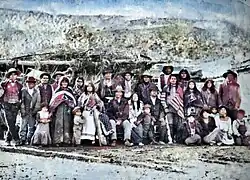Circleville Massacre
The Circleville Massacre was an 1866 lynching of 27 Southern Paiute Native American men, women, and children by members of Mormonism's largest denomination the Church of Jesus Christ of Latter-day Saints (LDS Church) in Circleville, Utah.[1][2][3]
| Circleville Massacre | |
|---|---|
| Part of The Black Hawk War | |
| Location | Circleville, Utah |
| Coordinates | 38°10′18″N 112°16′28″W |
| Date | April 21, 1866 |
| Target | Koosharem band of Southern Paiute people |
Attack type | Mass murder |
| Weapons | Blunt weapons, knives, guns |
| Deaths | 27 (children, women, and men) |
| Perpetrators | Members of the LDS Church |
| Motive | Paranoia towards Native American people during the Black Hawk War (1865–1872) |
Background
By 1866, Mormon and Native American confrontations were heated. Church officials ordered to have the Paiutes disarmed. Black Hawk and his band had killed many during the year before while defending their rights to their land. A determined camp of Koosharem Southern Paiutes remained in Circle Valley (Box Creek, now called Circleville), trying to be friendly with the LDS settlers. However, the LDS colonizers felt that they were in danger, as some other Native groups were fighting back and White settlers felt danger was imminent.[1][2]
Impetus
On April 21, 1866, an express from Fort Sanford reached Circleville, Utah telling of a Paiute who pretended to be friendly had shot and killed a white man belonging to the militia stationed at the nearby fort. The people of Circleville were told to protect themselves against the Native Americans who were camped in their valley. Upon receipt of this information, the people of Circleville called a town meeting. After much discussion, it was decided that they should arrest all the Paiutes that were camped nearby and bring them to Circleville for confinement.[1][2]
The massacre
Every able-bodied man in the town set out to take custody of the Native American camp, and they surrounded the camp at night. James T. S. Allred and Bishop William Jackson Allred went to the Native American camp and persuaded the Native Americans to come to a meeting at Circleville.[4] They told the Native Americans that they had received a letter and they wanted to have it read to them. All of the Native Americans agreed willingly to go to Circleville with the men, except one young Native American warrior who refused to go and began to shoot at the posse. The posse returned fire, killing the young man. The rest of the Native Americans were then taken at gunpoint to Circleville and the letter was read to them. The Native Americans were told that they were to be retained as prisoners.[1][2]
The Native Americans were taken into custody and placed in the meeting house that night under guard. The captured Native Americans, 26 in all, displayed much unrest. On the evening of the following day, some of the Native Americans were able to cut themselves loose from their bindings to escape.[5] Guards shot and killed two Native Americans who were attempting an escape. The remaining imprisoned Native Americans were moved to an underground cellar. In a subsequent town meeting, the settlers decided to kill the remaining imprisoned Native Americans. The Native Americans were led out of the cellar, totaling 24 people, including men, women, and children. They were struck on the back of the head to stun them and then their throats were slit, leaving them to bleed to death.[6] Two young boys and girl prisoner managed to escape before execution.[1][2] The bodies were secretly buried at night.[7]: 195
Aftermath

The following day, the three children were found in a nearby cave and taken by James Allred to Marysvale. Allred intended to sell or make a trade for the children. The little girl was killed by a violent bludgeoning. While the fate of one of the boys is unknown, the other Allred took him to Spring City. There, Allred spoke with Peter Monson to offer the boy for sale. A deal was struck for a horse and bushel of wheat in exchange for the boy. The boy lived in a tool shed and was welcomed because he befriended Peter Monson's daughter who had been disfigured by burns to her face. Peter and Bertha Monson then adopted the boy and named him David Monson.[1][2] In 2016, on the 150-year anniversary of the massacre a monument was dedicated in the town park to remember the Native Americans murdered nearby.[8][6]
References
- Reeve, W. Paul (April 2016). "Circleville Massacre, A Tragic Incident in the Black Hawk War". Utah State Department of Cultural & Community Engagement.
- "The Circleville Massacre". Paiute Indian Tribe of Utah. April 19, 2021.
- Winkler, Albert (1987). "The Circleville Massacre: A brutal incident in Utah's Black Hawk War". Utah Historical Quarterly. Utah State Historical Society. 55 (1) – via Brigham Young University.
- Erickson, Bethany; University, Brigham Young. "The Circleville Massacre". Intermountain Histories. Brigham Young University. Retrieved May 19, 2023.
- Johnson, Brandon (2007). "The Circleville Massacre". The Beehive Archive. Utah Humanities. Retrieved May 18, 2023.
- Wood, Benjamin (April 22, 2016). "'Forgotten' massacre of Utah Paiute group recalled with new monument". Salt Lake Tribune. Retrieved May 4, 2023.
- Catharine, Suzanne (July 31, 2014). "How Circleville Remembers". Utah Historical Review. Salt Lake City, Utah: University of Utah. Archived from the original on July 15, 2021. Retrieved May 18, 2023.
- "Circleville Massacre Memorial Dedication". Utah Historical Quarterly. Utah State Historical Society. 84 (3): 262–268. Summer 2016. doi:10.5406/utahhistquar.84.3.0262. S2CID 246576342 – via Issuu.